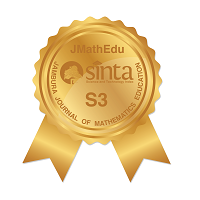Analisis Kemampuan Pemecahan Masalah pada Materi Bangun Ruang Sisi Datar di Kelas IX
Abstract
Keywords
Full Text:
PDF [INDONESIA]References
Peraturan Menteri Pendidikan Nasional (PERMENDIKNAS) Republik Indonesia No. 22 tahun 2016.
I. I. A. Ayubi, Erwanudin, dan M. Bernard, "Pengaruh Pembelajaran Berbasis Masalah Terhadap Kemampuan Pemecahan Masalah Matematis Siswa SMA", Jurnal Pembelajaran Matematika Inovatif, Vol. 1, No. 3, pp. 355-360, 2018.
W. A. Lubis, S. Ariswoyo, dan E. Syahputra, "Kemampuan Pemecahan Masalah Matematika Melalui Pendekatan Pendidikan Matematika Realistik Dan Pendekatan Penemuan Terbimbing Barbantuan Autograph", EDUMATIKA: jurnal riset pendidikan matematika, Vol. 3, No. 1, pp. 1-12, 2020.
N. P. R. Wulandari, N. Dantes, dan P. A. Antara, "Pendekatan Pendidikan Matematika Realistik Berbasis Open Ended Terhadap Kemampuan Pemecahan Masalah Matematika Siswa", Jurnal Ilmiah Sekolah Dasar, Vol. 4, No. 2, pp. 131-142, 2020.
K. A. Y. Pauweni and M. E. B. Iskandar, "Meningkatkan Kemampuan Pemecahan Masalah Matematika Melalui Model Problem-Based Learning pada Materi Bilangan Pecahan" Euler J. Ilm. Mat. Sains dan Teknol., vol. 8, no. 1, pp. 23-28, Apr. 2021, doi: 10.34312/euler.v8i1.10372.
P. W. C. Davita, dan H. Pujiastuti, "Analisis Kemampuan Pemecahan Masalah Matematika Ditinjau Dari Gender", Jurnal Matematika Kreatif-Inovatif, Vol. 11, No. 1, pp. 110-117, 2020.
F. Andayani, dan A. N. Lathifah, "Analisis Kemampuan Pemecahan Masalah Siswa SMP Dalam Menyelesaikan Soal Pada Materi Aritmatika Sosial", Jurnal Cendekia: Jurnal Pendidikan Matematika, Vol. 3, No. 1, pp. 1-10, 2019.
P. Akbar, A. hamid, dan A. I. Sugandi, "Analisis Kemampuan Pemecahan Masalah Dan Disposisi Matematik Siswa Kelas XI SMA Putra Juang Dalam Materi Peluang", Jurnal Cendekia: Jurnal Pendidikan Matematika, Vol. 2, No. 1, pp. 144-153, 2018.
K. Usman, I. Djakaria, dan S. Hasan. "Deskripsi Hasil Belajar Siswa Ditinjau Dari Kemampuan Pemecahan Masalah Matematika", Jurnal Karya Pendidikan Matematika, Vol. 8 No. 1, Universitas Negeri Gorontalo.
Fariha dan Ramlah, "Analisis Kemampuan Pemecahan Masalalah Matematis Siswa Berdasarlkan Prosedur Polya", Jurnal Ilmiah Pendidikan Matematika, Vol. 6, No. 1, pp. 43-59, 2020.
Z. Raudho, T. handayani, dan Syutarido, "Analisis Kemampuan Pemecahan Masalah Soal Pytagoras Berdasarkan Langkah-Langkah Polya", Suska Journal Of Mathematics Education, Vol. 6, No. 2, pp. 101-110, 2020.
N. H. Astuti, A. Rusilowati, B. Subali dan P, Marwoto, "Analisis Kemampuan Pemecahan Masalah Model Polya Materi Getaran, Gelombang, Dan Bunyi Siswa SMP", Unnes Physics Education Journal, Vol. 9, No. 1, pp. 1-8, 2020.
A. W. Abdullah, N. Achmad, and N. C. Fahrudin, "Deskripsi Hasil Belajar Matematika Siswa Melalui Pembelajaran Daring pada Pokok Bahasan Bangun Ruang Sisi Datar" Euler J. Ilm. Mat. Sains dan Teknol., vol. 8, no. 2, pp. 36-41, Dec. 2020, doi: 10.34312/euler.v8i2.10324.
Rhilmadinar, M. Ramli, dan B. I. Ansari, "Efektifitas Modul Pembelajaran berbantuan Software Geogebra Pada Matri Bangun Ruang Sisi Datar", Jurnal Didaktik Matematika, Vol. 7, No. 2, pp. 142-155, 2020.
P. Zakaria, N. Nurwan, and F. D. Silalahi, "Deskripsi Kemampuan Berpikir Kritis Siswa Melalui Pembelajaran Daring pada Materi Segi Empat" Euler J. Ilm. Mat. Sains dan Teknol., vol. 9, no. 1, pp. 32-39, Jun. 2021, doi: 10.34312/euler.v9i1.10539.
V. Damopolii, N. Bito, and R. Resmawan, "Efektifitas Media Pembelajaran berbasis Multimedia pada Materi Segiempat" Algoritm. J. Math. Educ., vol. 1, no. 2, pp. 74-85, 2019, doi: 10.15408/ajme.v1i1.
Mayasari dan T. Rosyana, "Pengaruh Kemandirian Belajar Terhadap Kemampuan Pemecahan Masalah Matematis Siswa SMP Kota Bandung", Jurnal Cendekia: Jurnal Pendidikan Matematika, Vol. 3, No. 1, pp. 82-89, 2020
R. J. Purnomo, S. A. Widodo, dan D. S. Setiana, "Profil Berpikir Siswa Dalam Memecahkan Masalah Matematis Berdasarkan Model Polya", Jurnal Pendidikan Matematika, Vol. 1, No. 2, pp. 101-110, 2020.
DOI: https://doi.org/10.34312/jmathedu.v2i2.10591
Refbacks
- There are currently no refbacks.
Copyright (c) 2021 Jambura Journal of Mathematics Education

This work is licensed under a Creative Commons Attribution-NonCommercial 4.0 International License.
Jambura Journal of Mathematics Education has been indexed by:
EDITORIAL OFFICE OF JAMBURA JOURNAL OF MATHEMATICS EDUCATION |
 | Department of Mathematics, Universitas Negeri Gorontalo Jl. Prof. Dr. Ing. B. J. Habibie, Moutong, Tilongkabila, Kabupaten Bone Bolango, Gorontalo 96554, Indonesia |
 | Email: [email protected] |
 | +6285255745923 (Call/SMS/WA) |
 | Jambura Journal of Mathematics Education (JMathEdu | eISSN: 2721-7477) by Department of Mathematics Universitas Negeri Gorontalo is licensed under a Creative Commons Attribution-NonCommercial 4.0 International License. Powered by Public Knowledge Project OJS. |



















